11 Fascinating Northern Cardinal Bird Facts
Updated: May 03, 2024
Meet the recognizable and beloved northern cardinal. Get cardinal bird facts, including why male cardinals are red, and where cardinals live.
On This Page
What Does a Northern Cardinal Bird Look Like?
It’s hard to resist a northern cardinal bird. They’re lively, bright and amazing songsters.
Amid the browns, blues and greens of the natural world, northern cardinals are showstoppers. And in winter’s soft white snow, these familiar birds are especially breathtaking. Their plumage makes them one of the easiest birds to identify and an accessible means of building birding skills.
Cardinals, affectionately known as redbirds, are often featured on Christmas decorations, in snowy scenes that take on vibrancy thanks to the dash of red.
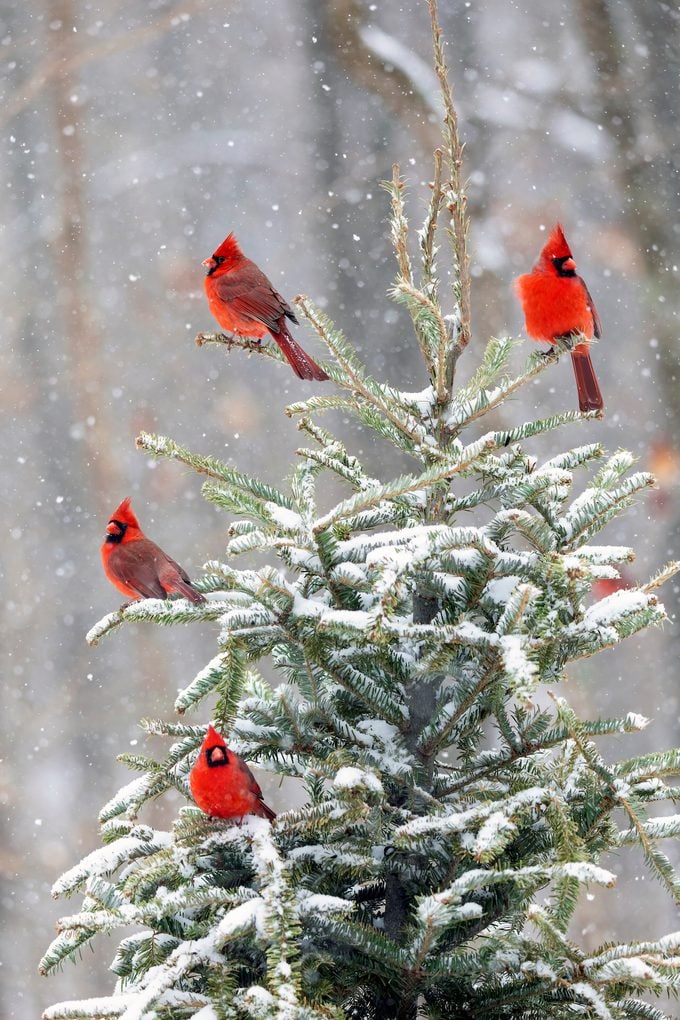
At about 9 inches, with a 12 inch wingspan, these popular birds are flashy members of the finch family.
Both sexes sport cute crests and reddish orange beaks. The bold red feathers birders have come to know and love adorn the males—making them nearly impossible to misidentify—while female cardinals feature beautiful brown feathers tinged with rosy accents. Both males and females have long tail feathers.
The key difference with juveniles is that they have black bills.
Check out simply stunning pictures of cardinals.
Northern Cardinal Bird Range
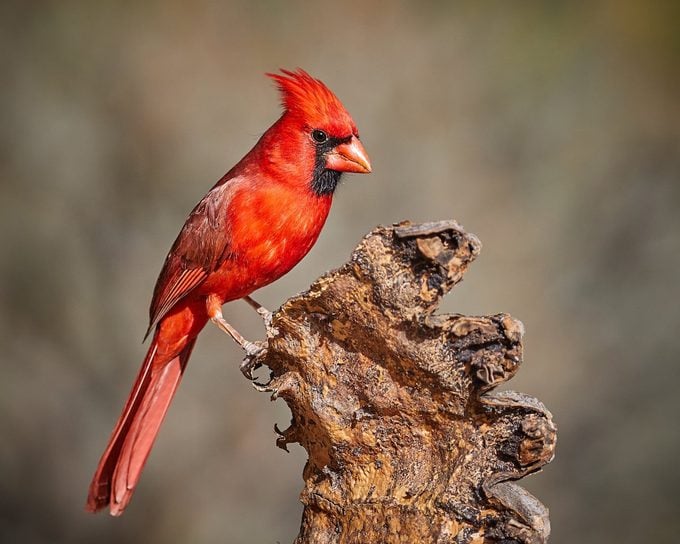
Primarily found east of the Rocky Mountains and in the Desert Southwest of the U.S., cardinals have a widespread scope. “They go all the way down to Mexico and Guatemala,” says David Wiedenfeld, senior conservation scientist at the American Bird Conservancy. Populations were also introduced in Hawaii.
Cardinals are abundant within their range. These birds are not migratory, so lucky residents of the eastern half of the U.S. get to enjoy these birds all year. They are the state bird of seven states.
If you see a cardinal, here’s what it means.
Cardinals may show up anyplace with dense low cover, such as backyards, parks, forest, swamps, even deserts. These birds thrive in towns and suburbs and the species has expanded northward from its historic range.
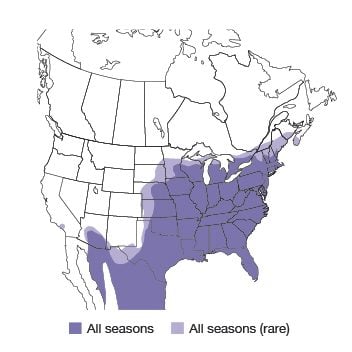
Range maps provided by Kaufman Field Guides, the official field guide of Birds & Blooms.
Did You Know: There are some regional variations in the species, especially in the Southwest and Mexico. Some scientists suggest that cardinals in the Sonoran Desert might be a different species from those found elsewhere in the United States, despite their proximity to northern cardinals in other southwestern deserts. Cardinals in the Sonoran Desert are somewhat larger, with longer crests, and the males are a paler red color. They also have slightly different songs.
Meet the 3 types of cardinals in North America.
Are Cardinals Territorial Birds?
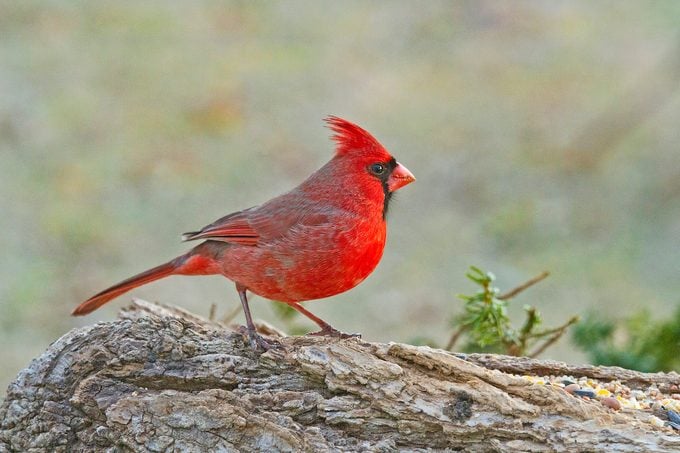
Northern cardinals are territorial during breeding season.
The roles among cardinals are clear. As resident birds, males establish and defend their territory through song—though they cross borders when food is scarce in the fall and winter. “This is when you see a lot of cardinals at your feeder together,” David says. Otherwise, “each pair owns a territory and generally keeps the others out.”
Birds & Blooms reader Mark Bolinger counted as many as three dozen cardinals at one time in his yard last winter, a mix of males and females. “Is this normal?” he asks.
Birding experts Kenn and Kimberly Kaufman explain, “Northern cardinals are flexible in their social behavior. During the breeding season, each pair is very defensive of their own territory, driving away other cardinals. But in fall, after breeding season ends, they become more tolerant of others. A flock may begin with a pair and their offspring from that year, and then other neighboring families may join them, concentrating where the most food is available. Cardinal flocks with as many as 100 birds have been reported, but these are rare, and gatherings of six to 20 are more typical. Your flock of three dozen was bigger than average.”
Do cardinals eat suet from bird feeders?
Both Male and Female Cardinals Sing
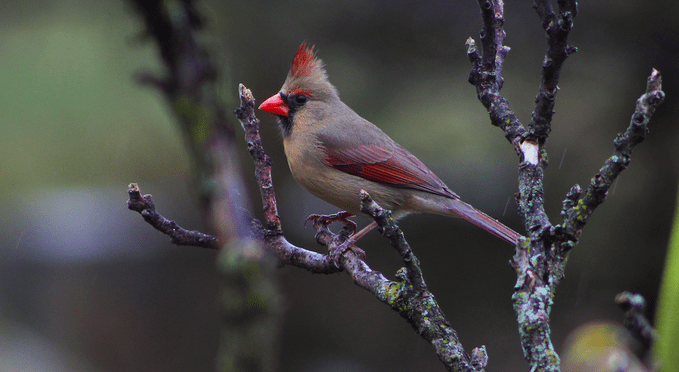
One fascinating northern cardinal bird fact—according to the Cornell Lab of Ornithology, cardinals are among the female North American songbirds that sing. They often do so while incubating their eggs to communicate to their mate to return with food for their family.
Female cardinals will also sing back and forth to reinforce pair bonding early in the breeding season.
Males sing at least nine months a year. Only during the deepest of winter months do they take a break from singing.
Cardinals sing more than 24 different songs. The most common is “What cheer! What cheer! What cheer!” Also listen for a repetitive pew, pew, pew, pew song. A cardinal’s call sounds like a high-pitched “chip!”
Bird songs provided by the Cornell Lab of Ornithology.
Cardinals Eat Seeds From Bird Feeders
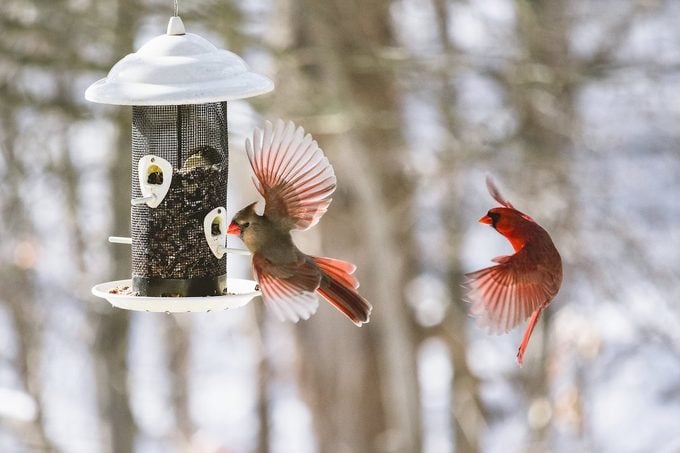
Attracting cardinals to your backyard feeding station is simple. Try a tube feeder or a tray feeder with large seeds such as sunflower or safflower, or sprinkle these seeds directly on the ground for cardinals to forage. They also devour dark-colored berries such as mulberries and blueberries.
Psst—here’s how to choose the best cardinal bird feeders and birdseed. Oh, and check out this DIY platform bird feeder you can make yourself to attract more cardinals to your backyard.
Northern Cardinal Nesting Habits
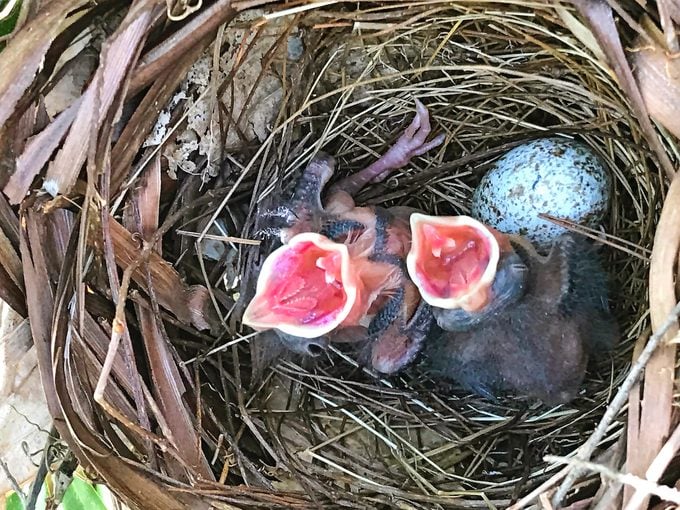
Cardinals generally stay in the same area, which helps get a jump-start on nesting, with some laying eggs by February. For their first nests in early spring, cardinals often choose the protection of evergreens. This long breeding season allows for multiple broods each year and ensures the survival of at least a few offspring. Cardinals aren’t too particular when it comes to nest location, and this generalist approach makes them susceptible to predation.
It takes three to nine days for a cardinal pair to build a nest, with the female cardinal doing most of the work. She lays three to four whitish-gray cardinal eggs with brown speckles in a nest of twigs and grasses hidden in a dense tree or shrub. Compared to other birds, their nests are low, only 4 to 8 feet off the ground.
The male cardinal bird dad stays near the nest. “Males become active parents when chicks hatch,” David says.
Young baby cardinals are pretty demanding—in the first days after they hatch, their parents feed them up to eight times an hour!
About 20% of mated pairs separate each year; however, most cardinal couples stick together for several breeding seasons. During the winter they are not as attentive to each other, and often feed separately.
Plant Dense Shrubs for the Ideal Cardinal Habitat
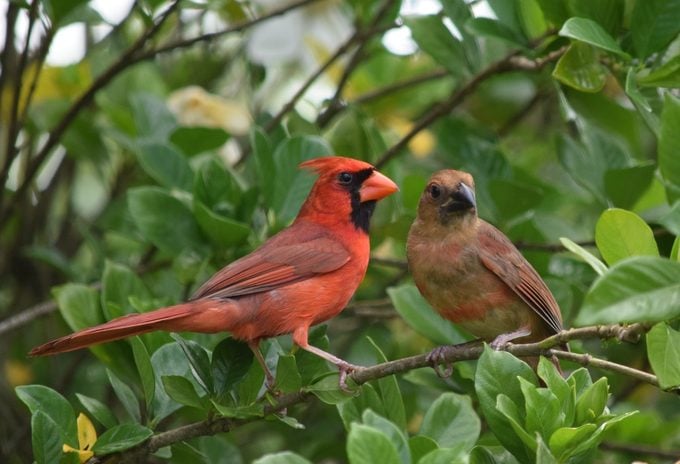
When it comes to their ideal habitat, cardinals appreciate the diversity of an open woodland. “They like to have some grass, shrubs and trees,” David says. Their cup nests are built in shrubs or low branches of trees, so incorporating native plants with these features into your backyard can help you create a cozy home for cardinals.
Thick cover provides good habitat for cardinals throughout the seasons. Hedgerows, shrubby stands, overgrown fields and forest edges all make suitable winter roosts. Planting a mix of small, dense trees and shrubs is ideal. Some cover trees and plants to try are box elder, eastern red cedar, nannyberry, and shrub roses. Wild grapevine is a good addition, too, because cardinals use its bark for nesting material.
Will a cardinal use a bird house?
Why Are Male Cardinal Birds Red?
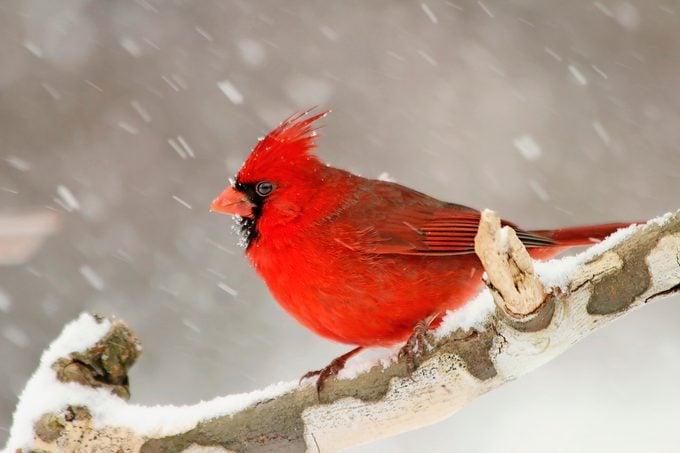
Another interesting cardinal bird fact—the male’s bold red coloration is thought to help attract mates. The brightness of plumage is related to diet. Male cardinals’ vivid red color comes from carotenoid pigments, which are found in red fruits. Eating more of these scarlet-hued berries, especially during molting, helps a male form brighter red feathers.
According to Birds of the World, studies indicate that the showier males tend to hold better territories, provide extra parental care and show higher nesting success.
Do cardinals eat suet from bird feeders?
Look for Rare Cardinal Birds in Other Colors
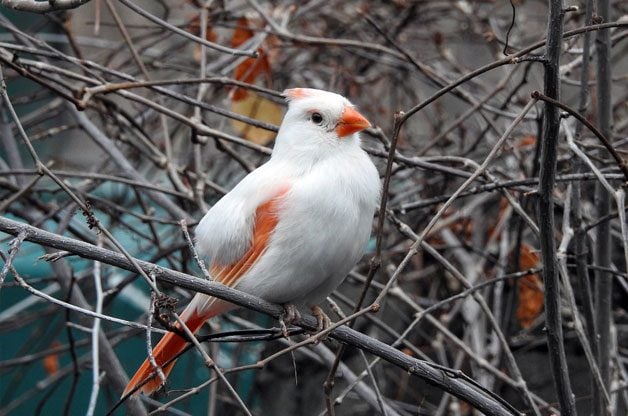
A rare genetic mutation called xanthochroism, which is not passed down, can make cardinals yellow instead of the familiar red. While different in color, they’re otherwise ordinary.
Cardinals sporting yellow feathers capture attention online. A simple search shows multiple news articles and stunning photos—and there’s even a Facebook page dedicated to one popular feathered friend: facebook.com/theyellowcardinal.

It was kind of surprising that of all the places this yellow cardinal (above) could make its home, University of Florida would be the one. But it’s a very pretty area—the bird has good taste!” says Birds & Blooms Field Editor Tom Dotson.
You may also be lucky to spot white cardinals and other leucistic birds.
A similar looking species in the southwest, the pyrrhuloxia, is sometimes called a desert cardinal. In Hawaii, South America and Puerto Rico, you may see the red-crested cardinal.
How Did the Northern Cardinal Bird Get Its Name?
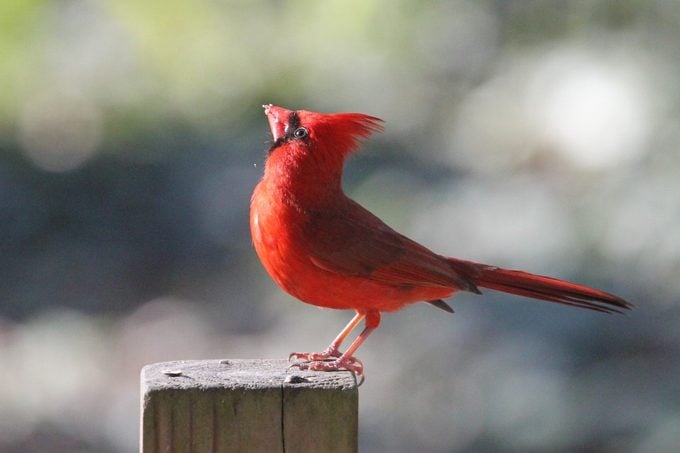
The source of the cardinal’s name may not be as obvious today, but in the 1600s and 1700s it was a well-known reference to the red garments worn by cardinals of the Catholic clergy.
This cardinal bird rescue story is simply amazing.
Can You Own Pet Cardinals?
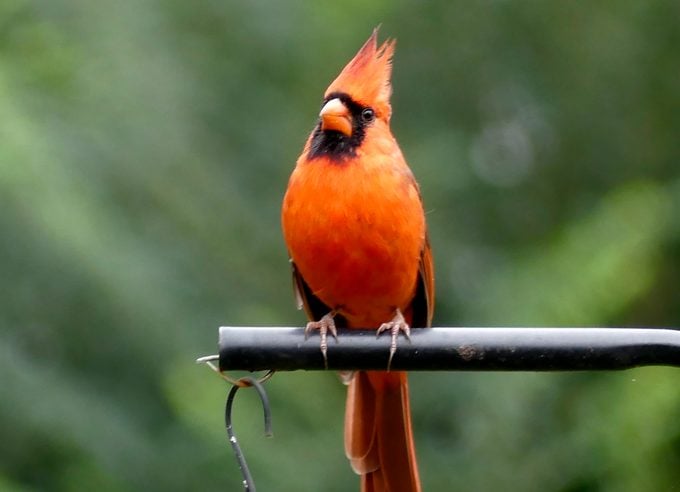
While you definitely can’t own a cardinal for a pet bird today, surprisingly, there was a time when it was OK to do so. Before the Migratory Bird Treaty Act of 1918, it was legal to keep wild birds as pets. Likely because of their color and sweet songs, northern cardinals were a popular choice.
The treaty was enacted to protect birds such as cardinals. “Prior to that, people kept pretty birds in cages, even native ones,” David says.
Sources
- Interview: David A. Wiedenfeld, Ph.D., Sr. Conservation Scientist, American Bird Conservancy
- All About Birds – northern cardinal





















